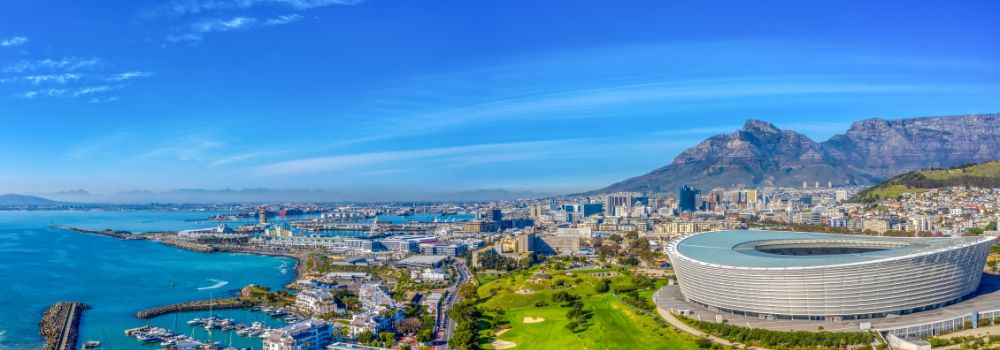South Africa Language and Culture

South Africa, also called the “Rainbow Nation,” has a rich and diverse cultural legacy. The country, close to Africa’s southernmost coast, is home to incredible wildlife, stunning natural surroundings, and intriguing artwork.
Currently, there are 60,467,336 people residing in South Africa. South Africa shares borders with Mozambique and Swaziland to the east, Botswana and Zimbabwe to the north, and Namibia to the Northwest. Both the Indian and Atlantic oceans surround the coastlines of South Africa.
Each of South Africa’s ethnic groups takes great pleasure in their linguistic and cultural heritage. The South African landscape is characterized by the savannah (tropical grassland) and semidesert (an arid region that receives more precipitation than a desert) ecosystems.
National and Local Languages of South Africa
There are eleven official languages in South Africa. The country’s media aims to speak as many of these languages as possible to reach the greatest number of citizens. Other languages, such as Portuguese, Greek, Italian, French, and Chinese, are also spoken. Some African languages of communication in South Africa include:
- AFRIKAANS LANGUAGE: Afrikaans, one of South Africa’s official languages, is spoken as a primary or secondary language by a substantial portion of the local population. Afrikaans have a fascinating past, and its traditions and culture are essential to its identity.
- NDEBELE LANGUAGE: Many South Africans communicate in Ndebele. It is said to be a wonderful language with a poetic tone. This Bantu language is spoken by the amaNdebele, a name commonly used to refer to Ndebele South Africans.
- VENDA LANGUAGE: Venda is a Bantu language that goes by Luvenda or Tshivenda. Interestingly, it has a kinship with the languages of the Congo and Niger. People who speak Tshivenda follow stringent customs that are related to their royal family lineage.
- XHOSA LANGUAGE: Amongst the eleven official South African languages, Xhosa is one of the most extensively used. 8.3 million South Africans, or 16% of the country’s total population, identify Xhosa as their mother tongue. The tongue creates various clicking sounds that are distinctive to the Xhosa language. The letters c, x, and q stand in for these.
- ZULU LANGUAGE: IsiZulu, most commonly shortened to Zulu, is one of this country’s 11 official languages. South Africa is home to the vast majority of the 10 million speakers of IsiZulu, and around 22.7% of South Africans speak Zulu at home, with up to 50% understanding it.
Religion in South Africa
South Africa is a secular state with a religiously diverse population and its constitution provides religious freedom. The ethnic and regional variety of the people includes several religions.
South Africa’s religious mix is dominated by Christians (68%), Muslims (2%), Hindus (1.5%), and indigenous believers (28.5%). Religious views are essential in public affairs because South Africans are practitioners.
Family Life in South Africa

South African families are caring, committed, and vocal. Religion is highly valued in many South African homes, and weekly attendance at religious activities is widespread. South African families are generally small units, with some living with extended family. Extended family members are meant to help and support one another in need. In metropolitan regions, both men and women work outside the house, but women are mostly the ones tasked with the responsibility of child-rearing and keeping the home.
Art and Architecture of South Africa
The extensive architectural history of South Africa includes contributions from all of the nation’s cultural groupings. The vast range of architectural projects that can be seen across the country, from simple homes to huge public and commercial structures, which highlight the most cutting-edge technology.
The clicking-sound language of the Xhosa people is a feature of South Africa’s art. The Xhosa were a communal tribe that raised livestock and cultivated the land. Traditional Xhosa homes were small and occasionally round in shape.
The oldest South African pieces of art were uncovered in the Blombos cave. Shell-shaped paint containers were discovered in an antique workshop, where mixed colors from diverse sources were maintained. The South African climate, particularly in this sea cave, is not conducive to the long-term survival of art, regardless of what they painted—clothing, faces, or the cave walls.
South African Food
South African food is a blend of different cultures and native cuisines, making it a really unique experience. Traditional South African dishes combine Dutch, Indian, Malaysian, Southeast Asian, and French cuisines and are brimming with flavor and spices.
- Bobotie: This delectable, minced beef is seasoned with a medium-hot curry, turmeric, garlic, lemon zest, onions, herbs, salt, and pepper. Many people like incorporating raisins. After baking until done, the dish is topped with an egg and milk mixture and returned to the oven to solidify. After the top custard-like layer has set, the dish is cut into squares and served over yellow rice (long-grain white rice cooked with turmeric and raisins), sometimes topped with melting apricot fruit.
- Biltong and Drowors: Biltong and drowors are cured pork delicacies. This regional specialty is generally consumed while watching the three most popular sports in the country—rugby, cricket, and football (soccer)—or during long road trips. Biltong is a traditional maritime method of preserving meat that is comprised of brined beef slices that are then hung to cure. Locals like biltong with thick layers of fat, although it is not considered nutritious.
- Potjiekos: The word means “food made in a pot” in Afrikaans. The traditional preparation method includes piling fresh vegetables and sauce on top of the meat while the cast-iron pot cooks over low heat, frequently over a small fire outdoors.
- Biryani: This meal is made with rice, meat, and Indian spices. The meat is often beef or chicken mince, although additional alternatives include goat, shrimp, pig, lamb, and fish. The Persian name “birian” means “fried before cooking,” is precisely how the dish is made: the rice and meat are cooked separately before being blended. The blended spices produce a powerful, balanced flavor that is not excessively spicy.
South African Fashion
The distinctive and traditional dress of South Africans varies by culture. Dashikis, beaded traditional attire, and brightly colored clothes things made of nwenda fabric paired with slacks are excellent examples of how to attain an exquisite ethnic look.
South Africa is similar to some European countries. Depending on the season, older women (40s and 50s) may wear capris or pants. The young females wear jeans. In the summer and spring, most individuals wear sandals. Saris and sherwanis are commonly worn for important occasions among the Indian population of South Africa. Wearing hijabs or scarves is relatively widespread in the South African Muslim communities, and it is also highly fashionable.
Common South African language expressions and their translations
- Yebo – Yes
- Cha – No
- Ngiyabonga – I thank you
- Ngicela – Can I please have …
- Ngiphuma e – (England) – I’m from (England)
- Unjani? – How are you?
- Kuhle – Good, fine
- Sala kakuhle – Goodbye (stay well)
- Ncela – Please
- Nceda – Help
- Yimalini – How much?
South African Holidays and Celebration
Some significant holidays and celebrations in South Africa Include:
- New Year’s Day – January 1st
- Human Rights Day – March 21st
- Family Day – April 22nd
- Freedom Day – April 27th
- Labor Day – May 1st
- Youth Day – June 16th
- Women’s Day – August 9th
- Heritage Day – September 24th
- Day of Reconciliation – December 16th
- Christmas – December 25th
- Day of Goodwill – December 26th
Doing Business in South Africa
 Launching a business in South Africa is hassle-free as no permits other than a business or work visa are required. Other requirements include:
Launching a business in South Africa is hassle-free as no permits other than a business or work visa are required. Other requirements include:
- Firm registration: The firm must be registered with the South African Registrar of Companies in Pretoria within 21 days after its opening.
- Registration with SARS (South African Revenue Service) The advantage of CIPC is that when you form a company, it is already registered with SARS.
- Protecting your Intellectual Property: In order to reduce the possibility of imitation, it is usually necessary to protect your “amazing ideas.” Trademarks, patents, designs, and copyrights are all examples of intellectual property owned by your business. CIPC is in charge of all of them.
- Requirements for employees on a basic and legal level: For your full-time employees, you must make sure that they are registered and in compliance with the following laws: Compensation for Occupational Injuries and Diseases Act 130 of 1993, which protects employees’ rights to health and safety while they are working.
- Consult a legal expert: You might not be aware of all the by-laws and rules that have an impact on the kind of business you can establish. Make sure to discuss this with a lawyer or someone else who works in the legal field.
Translating for the South African Market
It is essential to communicate your brand message in the South African language of your target audience. The constitution legally recognizes 11 of South Africa’s approximately 35 indigenous languages. The vast majority of South Africans speak these 11 languages.
Xulu, Xhosa, Afrikaans, Sotho, and Pedi are the five languages having the most speakers among the eleven. It is advisable to translate into these five most Spoken African languages.
Partnering with a language and localization services provider such as GPI will help ease the task of launching into the South African Market.
One of the world’s most cosmopolitan nations is South Africa. The population of urban regions is made up of many distinct ethnic groups. In addition to the native black people of South Africa, white Europeans, Indians, Indo-Malays, Chinese, and many more have immigrated there as a result of colonialism and immigration. Due to this variety, it is impossible to generalize all South African manners and cultures.
South Africans share many Western cultural customs and are incredibly kind, hospitable, and relaxed. Numerous smaller indigenous tribes exist, each with unique customs.
References:
